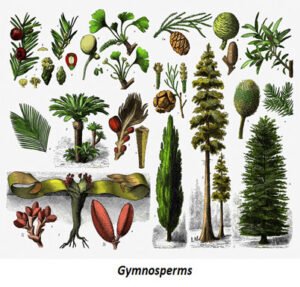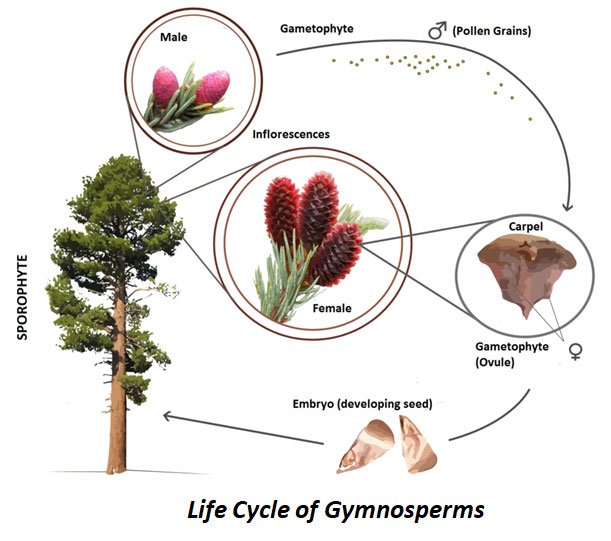Gymnosperms are a group of seed-producing plants characterized by naked seeds, typically borne on cones or strobili. They are among the earliest seed plants and have significant ecological and evolutionary importance. Unlike angiosperms, gymnosperms do not produce flowers or fruits. Understanding their origin, evolution, and diversification provides critical insights into plant evolution, paleobotany, and adaptation mechanisms over geological time.
Origin of Gymnosperms
The origin of gymnosperms can be traced back to the late Devonian period (approximately 360–380 million years ago). Fossil evidence indicates that gymnosperms evolved from seed ferns (Pteridosperms), which were an intermediate group between ferns and true seed plants.

Leipzig ; Berlin ; Wien : F.A. Brockhaus, Public domain, via Wikimedia Commons
Key points about gymnosperm origin:
- Derived from pteridosperm-like ancestors.
- Early gymnosperms were primarily woody plants with secondary growth.
- They developed seeds as a reproductive adaptation for survival in drier habitats, unlike spore-producing ferns.
- Fossilized ovules and pollen cones provide evidence of early seed plant evolution.
| You may also like NOTES in... | ||
|---|---|---|
| BOTANY | BIOCHEMISTRY | MOL. BIOLOGY |
| ZOOLOGY | MICROBIOLOGY | BIOSTATISTICS |
| ECOLOGY | IMMUNOLOGY | BIOTECHNOLOGY |
| GENETICS | EMBRYOLOGY | PHYSIOLOGY |
| EVOLUTION | BIOPHYSICS | BIOINFORMATICS |
Evolution of Gymnosperms
Gymnosperms represent a critical evolutionary step between non-seed plants (like ferns) and angiosperms. Their evolution is characterized by structural, reproductive, and ecological adaptations:

Jhodlof (tree photograph), JJ Harrison (female cones photograph), Beentree (male cones photograph), MPF (ovuliferous scale and seeds photograph), RoRo (final life cycle diagram), CC BY-SA 3.0, via Wikimedia Commons
Structural Evolution:
- Development of vascular cambium for secondary growth.
- Formation of woody stems and robust root systems for support and nutrient transport.
Reproductive Evolution:
- Seeds replaced spores, providing protection and nourishment for the embryo.
- Pollen grains evolved for airborne fertilization, allowing reproduction without water.
- Male and female reproductive structures became specialized cones (microsporangiate and megasporangiate).
Ecological Evolution:
- Adaptation to dry and cold environments, such as temperate forests and alpine regions.
- Evolution of needle-like leaves to reduce water loss.
- Development of resin canals for defense against herbivores and pathogens.
Diversification of Gymnosperms
Gymnosperms underwent significant diversification during the Carboniferous and Mesozoic eras. Today, gymnosperms are classified into four major divisions:
Cycadophyta (Cycads):
- Palm-like plants with large pinnate leaves.
- Primarily tropical and subtropical distribution.
- Fossil records date back to the Permian period.
Ginkgophyta (Ginkgo):
- Represented by the living fossil Ginkgo biloba.
- Fan-shaped leaves with dichotomous venation.
- Once widespread, now restricted to cultivation and a few wild populations (endemic).
Coniferophyta (Conifers):
- Include pines, firs, cedars, and cypresses.
- Predominantly found in temperate and boreal regions.
- Woody trees with needle-like leaves and cones.
Gnetophyta:
- Small group including Gnetum, Welwitschia, and Ephedra.
- Exhibit some angiosperm-like features such as vessel elements in the xylem.
- Adapted to arid and tropical habitats.

Ginkgo and Pinus
Factors Driving Diversification
- Climatic changes: Gymnosperms adapted to varying temperatures and moisture levels.
- Pollination mechanisms: Wind pollination allowed colonization of drier regions.
- Seed adaptation: Seeds provided an advantage over spore-producing plants in harsh conditions.
- Competition with angiosperms: Gymnosperms occupy ecological niches where flowering plants are less dominant.
Significance of Gymnosperm Evolution
- Gymnosperms were the dominant flora of the Mesozoic era, forming vast forests.
- They contributed to coal formation and shaped ancient ecosystems.
- Their evolutionary traits laid the foundation for the emergence of angiosperms.
- Gymnosperms are important in forestry, horticulture, and medicine today.
Conclusion
The origin, evolution, and diversification of gymnosperms reflect their adaptation to terrestrial life and ecological resilience over millions of years. From their seed fern ancestors to modern conifers, cycads, ginkgos, and gnetophytes, gymnosperms demonstrate remarkable structural and reproductive innovations. For students of botany, studying gymnosperms provides a crucial understanding of plant evolution, adaptation, and the transition from primitive seed plants to advanced angiosperms.
Download Quick Note PDF on Origin and Evolution of Gymnosperms PDF
FAQ on Origin and Evolution of Gymnosperms
Short Essay Questions (5–6 sentences expected)
- Discuss the evolutionary significance of seeds in gymnosperms compared to spores in ferns.
- Explain the structural adaptations that enabled gymnosperms to thrive in drier environments.
- Briefly describe the four major divisions of gymnosperms and give one example from each.
- How did gymnosperms contribute to ancient ecosystems during the Mesozoic era?
- Why is Ginkgo biloba considered a living fossil, and what makes it unique among gymnosperms?
Essay-Type Questions (longer, detailed answers expected)
- Trace the origin and evolutionary history of gymnosperms from their seed fern ancestors to modern groups, highlighting key structural and reproductive innovations.
- Discuss the diversification of gymnosperms with reference to climatic adaptations, reproductive strategies, competition with angiosperms, and their ecological and economic significance.
Download the Answer Key of these Questions in PDF
| You may also like... | ||
|---|---|---|
| NOTES | QUESTION BANK | COMPETITIVE EXAMS. |
| PPTs | UNIVERSITY EXAMS | DIFFERENCE BETWEEN.. |
| MCQs | PLUS ONE BIOLOGY | NEWS & JOBS |
| MOCK TESTS | PLUS TWO BIOLOGY | PRACTICAL |
<<< Back to Gymnosperms Quick Notes Page
🌱 Thanks for checking out this post on Origin and Evolution of Gymnosperms
I’d love to know what you think—did you enjoy it, have any questions, or maybe a fun fact to add? 🤔✨
Drop your thoughts in the comments—I read them all and they really keep me motivated to share more cool Biology stuff with you! 💬💚
-Admin, EasyBiologyClass
